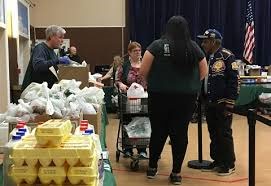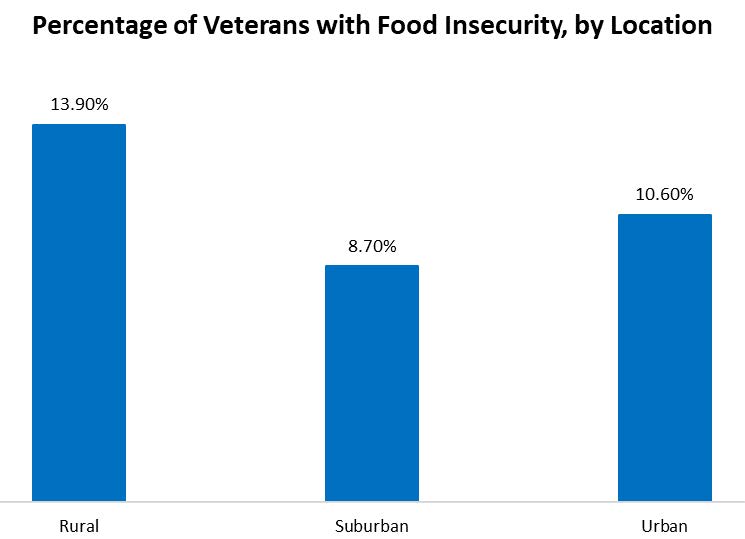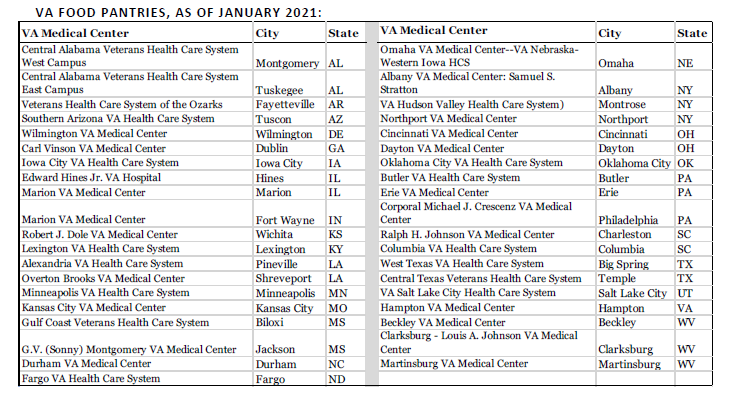Ensuring Food Security In Veterans
Ensuring Food Security in VeteransJaime Boris, MS, MHA(c), Office of Health Equity, Lauren Korshak, DHealth(c), MS, RCEP, Office of Health Equity, Shawn Liu, MSW, Homeless Programs Office, Alicia Cohen, MD, MSc, FAAFP, Research Investigator and Primary Care, VA Providence Healthcare System |
 |
We would like to extend a special thanks to the Economic Research Service and the United States Department of Agriculture (USDA) for their assistance in the development of this brief.
Download PDF
INTRODUCTION
The Veterans Health Administration (VHA) serves a Veteran population that is increasingly diverse. Equitable access to high-quality care for all Veterans is a major tenet of the VA healthcare mission. The Office of Health Equity (OHE) champions the elimination of health disparities and the achievement of health equity for all Veterans, including ensuring that Veterans have the same access to health opportunities as non-Veterans.
Access to healthy and nutritious food is a key component to good health. Working age Veterans are 7.4% more likely to experience food insecurity than demographically similar non-Veterans. Food insecurity occurs when people lack reliable access to nutritionally adequate food. Since food insecurity is associated with many negative health outcomes, alleviating food insecurity is essential to maintaining wellness.
HEALTH DISPARITIES
Researchers at the Economic Research Service (ERS) at USDA studied the extent and severity of food insecurity among working-age Veterans, ages 18–64 and then compared them to demographically similar non-Veterans. The ERS focused on working-age Veterans because they currently make up 76% of the Veteran population.
Between 2015 to 2019, 11.1% of working-age Veterans lived in food-insecure households, resulting in disrupted eating patterns and household members may reduce food intake due to limited resources.
Food insecurity was higher among working-age Veterans living in households in rural areas than in urban areas or in suburbs/exurbs.

From: Rabbitt, Matthew P. and Michael D. Smith May 2021. Food Insecurity Among Working-Age Veterans, ERR-829, U.S. Department of Agriculture, Economic Research Service.
REDUCING DISPARITIES AND IMPROVING ACCESS
Supplemental Nutrition Assistance Program (SNAP) benefits can help Veterans afford food. 7.1% of Veterans participate in the program, compared to 15% of non-Veterans. Similarly, only 20% of low-income households that utilized charitable food and nutrition assistance included a Veteran.
The Office of Health Equity supports interventions across VA to reduce health disparities in all Veteran groups. VA clinical care team members screen Veterans using the Hunger Vital SignTM. If the Veteran screens positive, they are offered a referral to a registered dietitian or social worker to receive education that helps them manage food resources, get connected to a local food pantry or community-based program, or enroll in SNAP. So far, VA has conducted over 10 million food insecurity screens for over 7 million individual Veterans.
VA established food pantries on many VA campuses, including several through a formal partnership between VA and Feeding America. Veterans felt empowered, were treated with dignity, and experienced minimized stigma when using these food pantries.
Additionally, a new partnership with MAZON: A Jewish Response to Hunger helps eligible Veterans access SNAP benefits through screening, education, and outreach. Increasing awareness and utilization of benefits is an important way to help Veterans access healthy food and maintain healthy lifestyles.
The full report on Food Insecurity Among Working Age Veterans can be accessed here.
For more information about the Office of Health Equity visit: https://www.va.gov/healthequity/




















